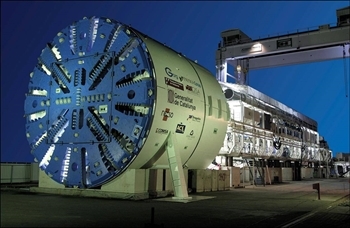PPP Profiles is an ongoing series of case studies on national and international public-private partnerships. To share ideas for future profiles, please contact Chrissy Nichols at cnichols@metroplanning.org.
Location: Miami, FL
Project Sponsor: Florida Dept. of Transportation (FDOT), Miami Access Tunnel, LLC (MAT), Miami-Dade County, City of Miami
Private Partner: Miami Access Tunnel, LLC (MAT): Meridiam Infrastructure Finance, S.a.r.l. (90 percent equity partner) and Bouygues Travaux Publics, S.A. (10 percent equity partner)
Project Delivery: Design/Build/Finance/Operate/Maintain
Cost: $1.1 billion
- Design and construction - $607 million
- Financing and other capital costs - $195.1 million
- Special Purchase Vehicle Costs/Insurance/Operating & Maintenance during construction - $59.6 million
- Reserves - $41.2 million
- State development cost - $209.8
Funding Sources:
- Senior bank debt - $341.5 million
- Transportation Infrastructure Finance and Innovation Act Loan: - $341 million
- Equity contribution - $80.3 million
- FDOT milestone payments during construction - $100 million (total)
- FDOT development funds - $209.8 million
Miami leaders had a problem: The Port of Miami brings billions of dollars in economic activity to the region each year, but the only way for the 16,000 trucks, cruise line busses, and cars to get to the port is to travel through downtown Miami. Not only does that cause major congestion downtown and present a pedestrian safety hazard, it restrict the port’s ability to grow and drives up costs for port users.
To solve the congestion problem, the Florida Dept. of Transportation (FDOT), Miami-Dade County, and City of Miami partnered with Miami Access Tunnel, LLC (MAT) to build the Port of Miami Tunnel, a $1.1 billion, 3.6-mile, four-lane tunnel under Biscayne Bay that will allow easy access to the port directly from Interstate 395. The tunnel will remove thousands of commercial trucks and cruise line busses from local streets, improving traffic flow and safety for vehicles and pedestrians in downtown Miami, and allow quick access to the port. Construction began in May 2010 and is expected to be completed in May 2014. MAT will design, build, finance, operate, and maintain the 42-foot diameter tunnels.
Lessons Learned
Innovative Financing
The Port of Miami Tunnel was a particularly challenging public-private partnership (PPP) to put together; the global economic crisis temporarily cancelled the project in 2008, the final procurement phase took almost four years, a tunnel-boring machine big enough to bore the twin 42-foot tunnels under Biscayne Bay had to be manufactured and transported from Germany, and ironing who was responsible to pay for damages if a hurricane struck during construction or the tunneling contractor ran into a problem digging under Biscayne Bay.
FDOT completed the deal because they remained flexible during a fragile investment market. After the original equity partners pulled out, FDOT accommodated Meridiam Infrastructure as the lead contractor’s choice for an equity partner. When the monoline insurance market vanished and the private activity bond market weakened, FDOT turned to the Transportation Infrastructure Finance and Innovation Act (TIFIA) federal loan program for funding. The project would not have been completed without this federal support.

Boaring machine that will dig the twin 42 foot tunnels under Biscayne Bay.
Innovative Program Delivery
Because the tunnel will not be tolled, FDOT will repay MAT through construction milestone and availability payments. The Port of Miami Tunnel is the nation’s second transportation concession to use this type of payment structure, which compensates the PPP developer for an achieved level of service and distributes risk between government stakeholders and private partners. In addition to the $100 million in construction milestone payments, MAT will receive a $350 million payment upon completion of construction. FDOT will also make availability payments to the company during the maintenance and operations portion of the contract. These payments will begin once the tunnel opens to the public and will continue for the remainder of the 35-year agreement. If the roadway is in disrepair or the tunnel is not open for use, MAT will not receive full -- if any -- payment for that period. The tunnel will be returned to FDOT in first-class condition at the end of the contract in October 2044.
Economic Benefits
The economic benefits of the Port of Miami Tunnel cannot be overstated. The Port currently provides 176,000 jobs, $6.4 billion in wages, and $17 billion in economic output for the region. Port-tunnel construction will bring an additional 600 direct jobs and another 33,000 jobs to the region as a result of that spending.
Expansion of the Panama Canal will be completed in 2014 and will dramatically increase the amount of Asian cargo unloaded on the East Coast. The Port Tunnel will be able to handle the additional traffic associated with the canal expansion, which also will benefit the industrial real estate market. According Jones Lang LaSalle, "The expansion of the Panama Canal could be a game-changer for South Florida industrial real estate … We expect to see an increase in demand for industrial space to accommodate the increased volume of container traffic flowing through the Port of Miami. The increased trade will also lead to expansion of ancillary businesses not directly tied to the Port such as customs brokers, freight forwarders and logistics firms, all who will need additional warehouse and office space in Miami."
Further, eliminating the port traffic from downtown streets will allow downtown Miami’s continued development . Since 2002, downtown Miami has realized almost $13 billion in new development and an almost 60 percent increase in population.
Bond Buyer named the Port of Miami Tunnel Project the 2010 Deal of the Year and Project Finance International named the Port of Miami Tunnel its 2009 Americas P3 Deal of the Year.